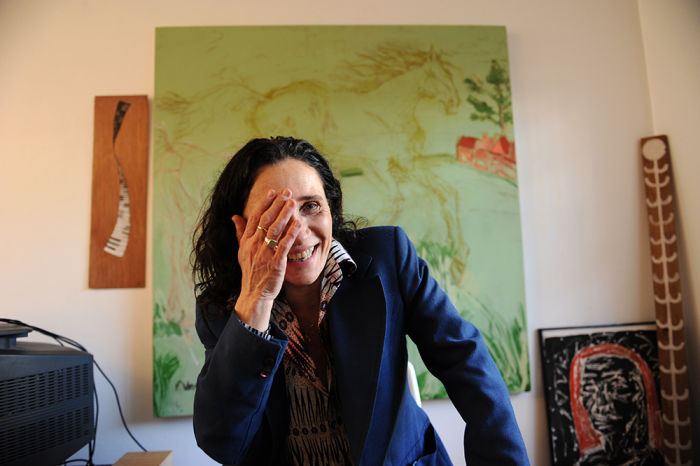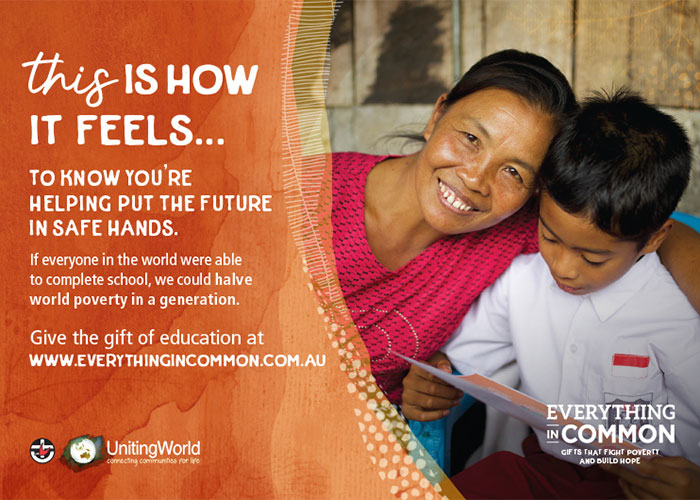Since then there has been lots of pressure to curate shows, but Teena’s work has remained her priority.
Born in Western Australia in 1962, Teena lived in Perth until she was 18 years old, then moved to Sydney as quickly as she could. “I never felt like I fitted in WA. Even as a child I had this image of being called to the bush, with old people painted up.”
This image haunted her and fragments of experiences and memories led her to suspect, from an early age, that the disruption in her family ran deeper than domestic drama. Questions about her nana and father became overwhelming.
“I remember being at Nan’s on the swings then we went to Sister Kate’s.”
Sister Kate’s Children’s Orphanage had been set up by the infamous AO Neville, WA Chief Protector of Aboriginals, who from 1915 to 1940 engineered the policy of removing children from their parents. These children became known, during the Royal Commission, as the Stolen Generation.
Questions abounded for Teena. Why was her Nan so drawn to this place, full of displaced mothers and children seeking out something? “Nana was a single woman. She worked as a domestic as a single mother (on outback stations) and would hide her son, Roy, when the authorities came round to remove the half-caste children. Nan lived in that street near Sister Kate’s. Everyone in the street was stolen or had relatives there. It was a bit of a hub.”
Roy, Teena’s dad, was removed under neglect laws. Sister Kate had advocated strongly against AO Neville’s draconian laws. She said there had to be a reason for removal. In the Aboriginal community, she was perceived as a good woman.
Twenty years ago, Teena began a conscious journey to get confirmation of her Aboriginality. In 2009, in Canberra, it was granted. Her nana had been born and raised in Broken Hill. She was an Aboriginal woman. “It suddenly meant my world had consolidated. I was a white fella but a black fella at heart. A billion signs throughout my life and suddenly I am who I am and this is who my father is. It meant I could acknowledge the life of my amazing Nana, in a way they weren’t able to when they were alive.”
But the Stolen Generation, her father’s mob, didn’t have country. She is looking forward to travelling to Broken Hill, hoping to meet family and further fill out her identity.
It hasn’t been an easy path. “This place called Australia apparently isn’t racist, but now I cop it, now there is an assumption, a snappiness, weird behaviour I’d never noticed before. Or the opposite, that it’s cool now to be Aboriginal. I’ve had lots of questions about which part of me is Aboriginal, or do I dot paint now?”
“I’m also proud of my Italian heritage (on her mother’s side) – maybe I’ll do a dot painting on a pizza!” she jokes. She has painted all her life since she was a little girl. “Mum encouraged me to paint, sing, dance, but it was always painting.”
She is studying at COFA, an opportunity she describes as “humbling”. “Part of acknowledgement means I can paint who I am. It’s a healing.”
Although she didn’t set out to do political work, she says if she can say something in her art, that’s a bonus. “I’m concerned with country, treatment of land and of First Peoples.”
Painting about the Intervention became obvious and captured people’s imagination.
Her artwork now is about removing the artist from the work. Using a complex 14-day process, she is drying and stretching pandanis palm fronds, then placing them outside and allowing rain and seasons to do their work. She then restyles the fronds and throws organic paint from a height onto them, again leaving them to the weather.
Teena describes herself at the moment as “on a road in between two worlds”, the former life and the new one. “I know who I am but have yet to find out my true heritage, then I think true healing will begin. Knowing Roy was removed will sort out all sorts of issues.”





